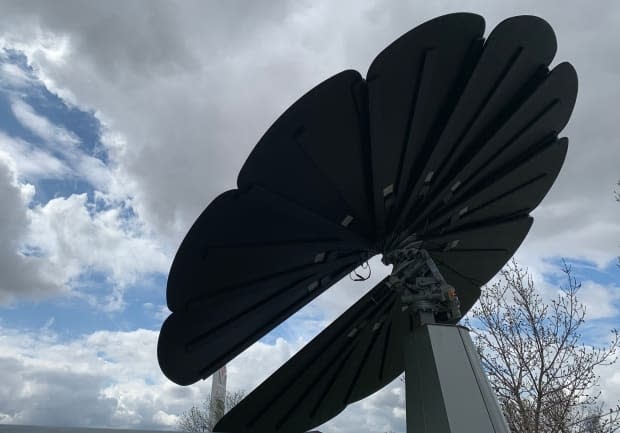Solar flower provides power to Saskatoon high school while inspiring students

Its bright green roof has always made Bishop James Mahoney Catholic High School in Saskatoon easy to spot. Now the school is turning heads for a different reason: a giant flower on its lawn.
The five-metre tall flower made of cement, metal, and silicon is called a Smartflower. Its petals are solar panels that draw energy from the sun and feed it into the school through a microgrid.
A microgrid is a type of electrical grid that only holds a small amount of power compared to the grids that power the city or province.
Aaron Genest, with Siemens Canada, one of the partners of the project, says this is a unique opportunity for students.
Genest says the microgrid feeding the school is not only providing energy, it is also providing educational opportunities for students.
"The kids can look at what's going on, change the way that it operates by optimizing how it works between the draw and the generation and the storage, and they can plug things in and do their own school projects with it," said Genest.

The solar flower responds to its environment. It opens — or blooms — when the sun is shining, and closes and cleans itself at night. It is also able to detect high winds and will close up to protect itself.
Collège Sainte-Anne, a private school in Montreal, uses a similar solar flower to power lights in a parking lot.
It's literally groundbreaking. - Andrea Regier
While the Saskatoon solar flower is fully operational now, it will not be incorporated into the curriculum until the next school year.
Andrea Regier, program lead of the health and science academy at Bishop James Mahoney School, says seeing the flower operational is giving students a charge.
"It's literally groundbreaking, you know, in so many ways. And it's exciting," said Regier. "Certainly empowering, perhaps. Pun intended there."
Starting in the fall, students will study how the technology works. Science is the obvious connection point, but as they learn more about the flower, Regier expects to see it extend into other areas of the curriculum.
"You start to think about ethical decision making and start to think about computer programming or extending beyond into computer science … perhaps politics and decision making," said Regier.

Janet Uchacz-Hart is the executive director of the Saskatoon Industry Education Council, another partner. She says the project is not just about what students are learning now, but how they apply this knowledge in the future.
"We know that green technology is going to be critical to Saskatchewan and to the world," said Uchacz-Hart. "And so we want to be on the forefront to really educate our young people about what it is, how important it is for climate change, and then be able to capture that and then to be able to get them to learn about it."
Regier says students are already starting to think about careers they never knew existed.
"I think when you have something like this Smartflower to start the conversation, it starts to make students think beyond the classic choices for post-secondary careers," said Regier.

The project comes with a hefty price tag. The government of Saskatchewan made a one-time investment of $158,000 from Innovation Saskatchewan and the Ministry of Immigration and Career Training.
Still, just like any flower, those who planted the seeds would like to see a lot of growth.
"Hopefully some of our school divisions may want to incorporate this into their classrooms throughout the province," said Uchacz-Hart.


